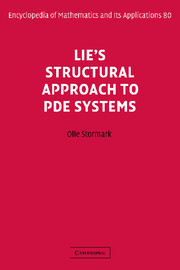Book contents
- Frontmatter
- Contents
- Preface
- 1 Introduction and summary
- 2 PDE systems, pfaffian systems and vector field systems
- 3 Cartan's local existence theorem
- 4 Involutivity and the prolongation theorem
- 5 Drach's classification, second order PDEs in one dependent variable, and Monge characteristics
- 6 Integration of vector field systems V satisfying dim V' = dim V + 1
- 7 Higher order contact transformations
- 8 Local Lie groups
- 9 Structural classification of 3-dimensional Lie algebras over the complex numbers
- 10 Lie equations and Lie vector field systems
- 11 Second order PDEs in one dependent and two independent variables
- 12 Hyperbolic PDEs with Monge systems admitting two or three first integrals
- 13 Classification of hyperbolic Goursat equations
- 14 Cartan's theory of Lie pseudogroups
- 15 The equivalence problem
- 16 Parabolic PDEs and associated PDE systems
- 17 The equivalence problem for general 3-dimensional pfaffian systems in five variables
- 18 Involutive second order PDE systems in one dependent and three independent variables, solved by the method of Monge
- Bibliography
- Index
16 - Parabolic PDEs and associated PDE systems
Published online by Cambridge University Press: 05 April 2013
- Frontmatter
- Contents
- Preface
- 1 Introduction and summary
- 2 PDE systems, pfaffian systems and vector field systems
- 3 Cartan's local existence theorem
- 4 Involutivity and the prolongation theorem
- 5 Drach's classification, second order PDEs in one dependent variable, and Monge characteristics
- 6 Integration of vector field systems V satisfying dim V' = dim V + 1
- 7 Higher order contact transformations
- 8 Local Lie groups
- 9 Structural classification of 3-dimensional Lie algebras over the complex numbers
- 10 Lie equations and Lie vector field systems
- 11 Second order PDEs in one dependent and two independent variables
- 12 Hyperbolic PDEs with Monge systems admitting two or three first integrals
- 13 Classification of hyperbolic Goursat equations
- 14 Cartan's theory of Lie pseudogroups
- 15 The equivalence problem
- 16 Parabolic PDEs and associated PDE systems
- 17 The equivalence problem for general 3-dimensional pfaffian systems in five variables
- 18 Involutive second order PDE systems in one dependent and three independent variables, solved by the method of Monge
- Bibliography
- Index
Summary
Chapters 12 and 13 were devoted to the study of those hyperbolic second order PDEs in one dependent and two independent variables for which each Monge system admits at least two functionally independent first integrals. In this and the following chapter we consider the corresponding problem for parabolic second order PDEs.
In this case also the theory started with a paper of Goursat—[Goursat 1895]—in bad need of clarification. Satisfactory such was presented in the ‘five variable paper’ [Cartan 1910], which in conformity with Vessiot's theory of hyperbolic PDEs points out the crucial role played by Lie groups when trying to understand the underlying reasons for the results obtained.
An arbitrary second order PDE S1 in one dependent and two independent variables can be regarded as a 7-dimensional submanifold of the 8-dimensional jet bundle J2(C2, C), provided with the restriction of the contact pfaffian system 2Ct2,1 of J2(C2,C) to S1. In this way our PDE is identified with a 3-dimensional pfaffian system P1 on a 7-dimensional manifold.
We restrict the study to parabolic PDEs for which the Monge system admits at least two functionally independent first integrals. A useful observation in section 16.1 is that the 2-dimensional Monge system is complete in this case, and hence in fact admits five functionally independent first integrals. Morover such a parabolic PDE may be identified with a 2-dimensional pfaffian system Q = (ω1,ω2) on a 6-dimensional manifold, and—the decisive point—this Q admits a Cauchy characteristic vector field. Because of the latter we are then reduced to finding integral curves of a 2-dimensional pfaffian system in five variables, whence we only need to solve ODE systems.
- Type
- Chapter
- Information
- Lie's Structural Approach to PDE Systems , pp. 442 - 470Publisher: Cambridge University PressPrint publication year: 2000

